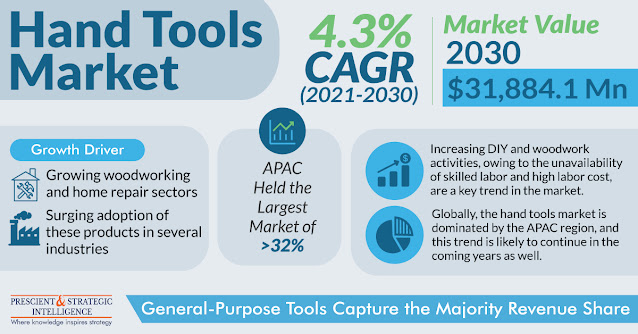In 2021, the hand tools industry generates $21,854.1 million revenue, and it is projected to rise at a rate of 4.3%, to capture $31,884.1 million revenue by 2030. It is ascribed to the rising construction, automotive, shipbuilding, and manufacturing sectors. Moreover, hand tools are highly utilized in the DIY and aerospace sectors for a range of applications, such as hammering, drilling, sawing, and others, resulting in industry expansion.
DIY and woodwork activities are rising due to the absence of skilled labor and expensive labor cost. Individuals prefer such a low-cost approach for enhancing the home outlook, interior decoration, and other furniture projects. Thus, the saved expenses from labor costs can be spent on quality raw materials. Moreover, the transforming lifestyle of consumers, increasing creative and fun activities, and availability of resources such as DIY guides, video tutorials, as well as how-to articles support people in doing such activities.
In addition, the rising demand for wood products is the major factor in industry proliferation. People are increasingly demanding wood-based products for their offices and homes. The increasing building and construction sector application of eco-friendly materials results in rising demand for wood furniture.
The construction sector captures a massive share of the industrial hand tools industry due to population explosion, surging urbanization, and growing demand for commercial and residential facilities, results, into growing demand for hand tools.
Moreover, the automotive sector is projected to rise at a rapid rate in the near future, led by the rising usage of industrial hand tools in repairing, modifying, and servicing automotive parts. In addition, the ease to use, and low cost of these tools, lead to their growing usage in garage modifications, DIY projects, and various other personal objects.
Therefore, the rising construction activities lead to the growing demand for hand tools for hammering, drilling, sawing, and various other purposes.














